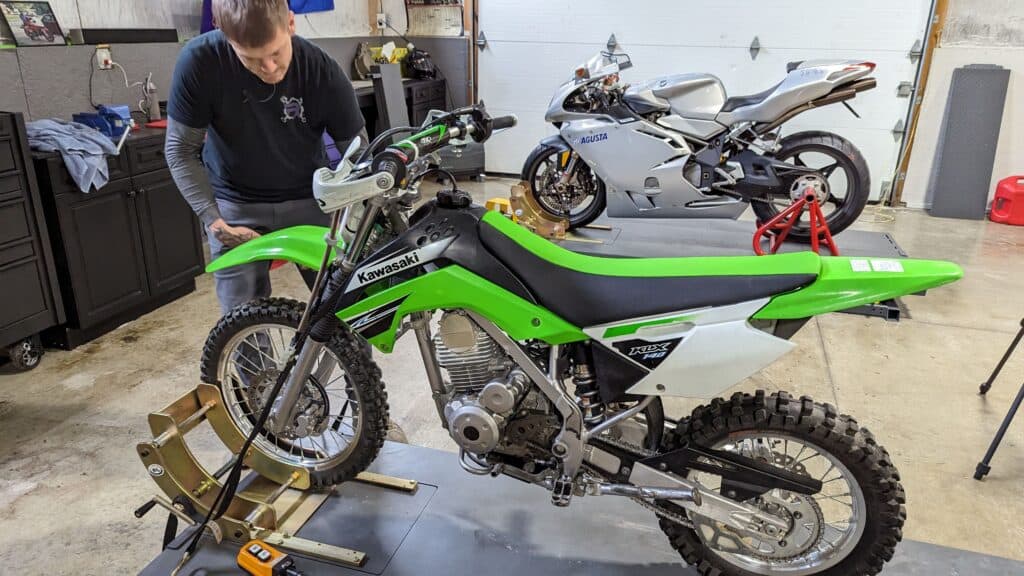Imagine you’re a motorcycle enthusiast gearing up for the winter season. As the cold weather approaches, you know it’s crucial to protect your bike from the harsh elements. We will show you what’s important when it comes to winter storage for motorcycles.
That’s why we’re here to share essential motorcycle storage tips for winter. From properly storing your battery to managing gasoline and preparing your bike for the frigid months ahead, we’ve got you covered.
Ready to dive into the world of winter storage for motorcycles?
Proper Battery Storage
To properly store your battery during the winter, always unhook it from the bike and consider using a trickle charger to keep it charged. This simple step can prevent the battery from draining and ensure that it stays in good condition.
When the battery is left connected to the bike, it can slowly lose its charge over time, especially in cold temperatures. By disconnecting it and using a trickle charger, you can maintain the battery’s charge level and prevent it from becoming completely drained.
This will help extend the lifespan of the battery and ensure that it is ready to go when you are ready to ride again in the spring. So, take a few minutes to unhook your battery and invest in a trickle charger for worry-free winter storage.
Managing Gasoline
Turn off the gas supply to the carburetor to prevent any damage caused by ethanol in gasoline. Ethanol can be harmful to carburetors, so it’s important to take precautions.
To ensure proper storage, drain the gas from the carburetor using the drain bolt and vent lines. This will empty the carburetor and protect the seals and jets from potential damage.

Avoiding Fuel Additives
Additionally, we recommend you avoid fuel additives like Seafoam. These additives can lead to fuel system issues and require extra maintenance. Stick to using only gasoline in the tank, preferably ethanol-free gasoline for carbureted motorcycles. It’s best to avoid using them altogether, but your mileage may vary.
Stick with regular gasoline, and if possible, opt for ethanol-free gasoline. Ethanol can damage carburetors. By sticking to gasoline only, you can ensure that your carburetor remains in good condition and that you don’t encounter any unnecessary problems.
Keeping it simple and straightforward will save you time, money, and headaches down the road. So, resist the temptation to use fuel additives and stick to using plain old gasoline for your carbureted bike.
Storing Two-Stroke Motorcycles
Plug the exhaust of your two-stroke motorcycle to prevent moisture and rust from damaging the expansion chamber. Moisture can wreak havoc on the delicate components of the expansion chamber, causing rust and corrosion.
By plugging the exhaust, you create a barrier that keeps moisture out, ensuring that your motorcycle’s performance remains intact. This simple step is crucial for proper storage and maintenance of your two-stroke engine. It helps protect the exhaust system from potential damage and ensures that your motorcycle is ready to hit the road when the winter months are over.
Winter Storage Preparations
To properly prepare your bike for winter, it is important to take certain precautions to protect it from cold weather damage.
Start by cleaning your motorcycle thoroughly and changing the oil and filter.
Remove the battery and store it properly, as cold temperatures can damage it. Inflate the tires to the recommended pressure to prevent flat spots.
Choose a dry and well-ventilated area for storage and use a motorcycle cover to protect it from dust. If possible, elevate the motorcycle off the ground to avoid moisture damage. Avoid storing it near chemicals or flammable materials.
Periodically start the motorcycle to prevent engine damage and rotate the tires to prevent flat spots. Lastly, inspect the bike for any signs of damage or pests before storing it.
Maintenance and Inspection Tips Come Spring
Inspect your bike regularly for any signs of wear or damage to ensure its proper maintenance. Check the tires for any signs of wear or punctures and make sure they are properly inflated to the recommended pressure.
You will want to examine the brakes to ensure they are functioning properly and have enough brake pad left.
Inspect the chain and sprockets for any signs of wear or rust and lubricate the chain if needed.
Check the lights to make sure they are all working and look for any leaks in the engine or other parts of the bike. Also, check the fluid levels and top them up if necessary.
Does Your Motorcycle Need More Attention?
We hope you find our articles helpful. If you are in the Columbus, Ohio, area and are looking to have your motorcycle repaired or service, we would appreciate you checking out Richardson Motoworks. We provide a premier concierge service: Schedule a time, and we will pick up your bike and drop it off when finished. We know you have a hectic and busy life. We’ll make maintaining a well-running motorcycle easier for you.